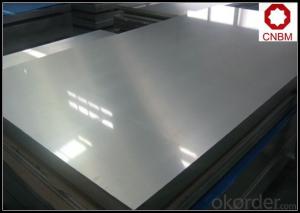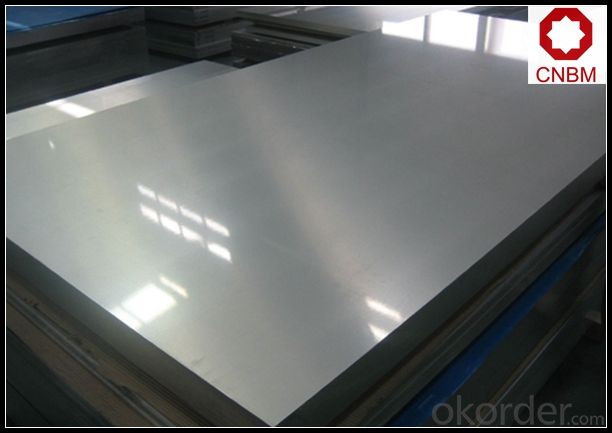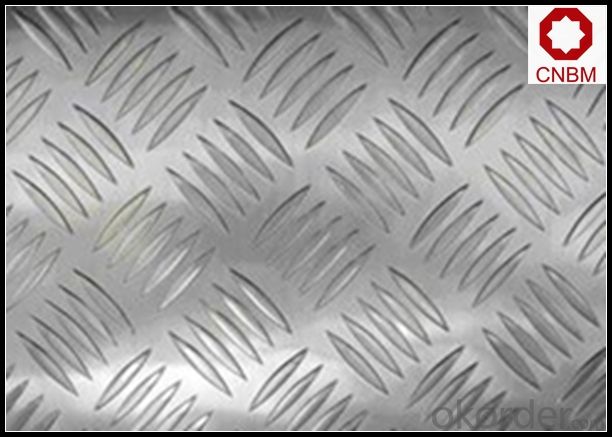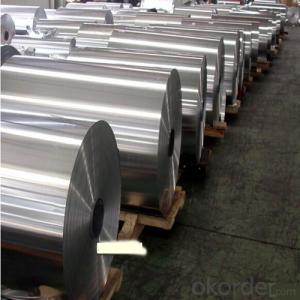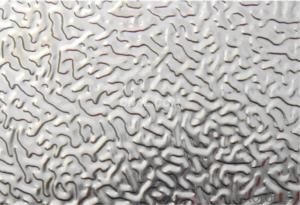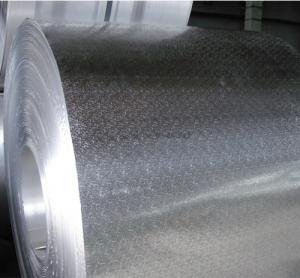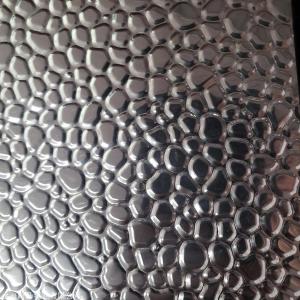Reflective Stucco Embossed Aluminum Coil for Transportation
- Loading Port:
- Shanghai
- Payment Terms:
- TT OR LC
- Min Order Qty:
- 5 m.t.
- Supply Capability:
- 10000 m.t./month
OKorder Service Pledge
OKorder Financial Service
You Might Also Like
Specification
1. Specification of Stucco Embossed Aluminum Coill for Transportation
1) Alloy | 1050, 1060,1100, 3003 3004 3105 3A21 5005 5052 etc |
2) Temper | O/H12/H14/H1/H18/H32/H34/H36/H38//H111/H112/H116/H321/T6/T651/T3/T351 etc |
3) Thickness | 0.1mm to 6mm |
4) Width | 20mm to 3300mm |
5) Coil weight | 100kgs to 6 tons depends on actual requirement |
6) Core material | Aluminum or paper |
7) Coil Inner diameter | 75mm, 150mm, 200mm, 300mm, 405mm, 505mm or as required |
8) Protective film can be added
2. Application of Stucco Embossed Aluminum Coill for Transportation
(1).Interior: wall cladding, ceilings, bathrooms, kitchens and balconies, shutters, doors...
(2).Exterior: wall cladding, facades, roofing, canopies, tunnels,column covers , renovations...
(3).Advertisement: display platforms, signboards, fascia, shop fronts...
3. Feature of Stucco Embossed Aluminum Coill for Transportation
*Such coil is specially designed to replace aluminum ingot, due to the high export tax of aluminum ingot, the coil has better price than ingot.
*This type of coil can fit customer's remelting furnace just like ingot, no need to make any change to the production line that was previously used for ingot. The standard coil size and weight is very suitable for the feed gate of furnace.
*This type of coil causes less material wastage than ingot when remelted.
*Our coil is made directly from ore, no need to go though the ingot making process, quality is much better than other suppliers who use ingot scrap to make coil.
Be free from Oil Stain, Dent, Inclusion, Scratches, Stain, Oxide Dicoloration, Breaks, Corrosion, Roll Marks, Dirt Streaks and other defect which will interfere with use
4. Certificate:
SGS and ROHS(if client request, paid by client), MTC(plant provided), Certificate of Origin(FORM A, FORM E, CO), Bureau Veritas and SGS (if client request, paid by client), CIQS certificate
5. Image of Stucco Embossed Aluminum Coill for Transportation
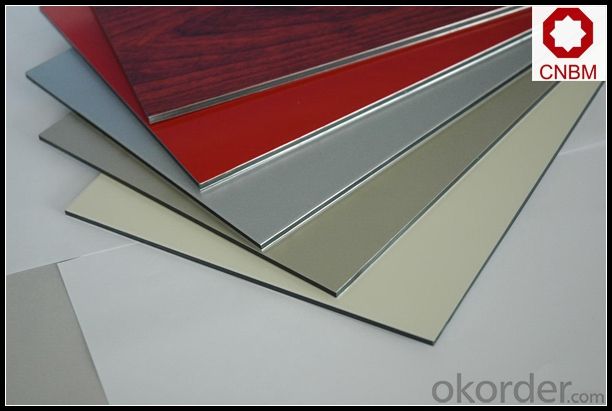

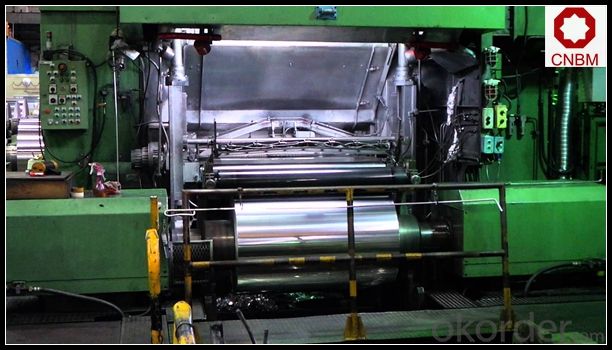
6. Package and shipping of Stucco Embossed Aluminum Coill for Transportation
eye to wall
eye to the wall
with wood pallet (wooded case also available)
7. FAQ
1) What is the delivery time?
Dpends on actual order, around 20 to 35 days
2)What is the QC system:
We have QC staff of 20 persons and advanced equipment, each production is with MTC traced from Aluminum ingot lot.
3) What market do you mainly sell to?
Australia, America, Asia, Middle East, Western Europe, Africa etc
- Q: What are the main causes of aluminum strip rolling?
- Also, what types of mill, simple four roll or roll type control of CVC and HC mills?
- Q: Can aluminum coils be used in the production of window frames?
- Yes, aluminum coils can be used in the production of window frames. Aluminum is a lightweight and durable material that is commonly used in the construction industry for its corrosion resistance and strength. By using aluminum coils, manufacturers can efficiently produce window frames that are long-lasting, energy-efficient, and aesthetically pleasing.
- Q: Can aluminum coils be used in the production of aluminum facades?
- Yes, aluminum coils can be used in the production of aluminum facades. Aluminum coils are commonly used in the construction industry for various applications, including the production of facades. The coils are typically made from high-quality aluminum alloy, which offers excellent durability, corrosion resistance, and aesthetic appeal. The coils can be easily shaped, cut, and formed to create the desired design and size for the aluminum facades. Additionally, aluminum coils can be coated with different finishes, such as powder coating or anodizing, to provide further protection and enhance the appearance of the facades. Overall, aluminum coils are a versatile and reliable material for the production of aluminum facades, offering a wide range of design possibilities and long-lasting performance.
- Q: How do aluminum coils contribute to energy savings in buildings?
- Aluminum coils are an essential component of HVAC (Heating, Ventilation, and Air Conditioning) systems in buildings, and they play a significant role in contributing to energy savings. Firstly, aluminum coils are highly efficient in transferring heat. HVAC systems use these coils to facilitate the exchange of heat between the indoor and outdoor environments. Aluminum's thermal conductivity allows for quick and efficient heat transfer, reducing the energy required to heat or cool a space. This means that HVAC systems equipped with aluminum coils can achieve the desired indoor temperature more efficiently, leading to energy savings. Moreover, aluminum coils are lightweight and have excellent corrosion resistance. This property ensures the longevity and durability of the HVAC system, reducing the need for frequent replacements. By having a longer lifespan, the energy and resources used in manufacturing new coils are saved, resulting in reduced energy consumption and environmental impact. Furthermore, aluminum coils are highly recyclable. When an HVAC system reaches the end of its life cycle, the aluminum coils can be easily recycled and repurposed. Recycling aluminum requires significantly less energy compared to producing new aluminum from raw materials. By promoting recycling, energy is conserved, and greenhouse gas emissions are reduced. Additionally, aluminum's reflective properties contribute to energy savings in buildings. When used in HVAC systems, aluminum coils can reflect and deflect sunlight, reducing the amount of heat absorbed by the building. This reduces the workload on the HVAC system, resulting in lower energy consumption and increased energy efficiency. In summary, aluminum coils contribute to energy savings in buildings through their high thermal conductivity, lightweight and durable nature, recyclability, and reflective properties. By using aluminum coils in HVAC systems, buildings can achieve optimal temperature control with reduced energy consumption, leading to significant energy savings and a more sustainable environment.
- Q: What are the different coil uncoiling options for aluminum coils?
- There are several different coil uncoiling options available for aluminum coils. These options vary based on the specific needs and requirements of the application. One common method is manual uncoiling, where the coil is unwound by hand. This is typically used for smaller coils or in situations where precision and control are important. Manual uncoiling allows for careful handling of the aluminum coil and is often used in smaller scale operations. Another option is mechanical uncoiling, which involves using a machine or equipment to unwind the coil. Mechanical uncoiling is suitable for larger coils or high-volume production. It allows for faster and more efficient uncoiling, reducing the labor involved in the process. Furthermore, there are specialized uncoiling machines available that can handle specific requirements. For instance, some machines are designed for delicate or sensitive materials and offer features like adjustable tension control to prevent any damage to the aluminum coil during uncoiling. In addition to these options, there are also custom uncoiling solutions that can be designed to meet specific needs. These solutions may involve different mechanisms or techniques to ensure the safe and efficient uncoiling of aluminum coils. Ultimately, the choice of coil uncoiling option depends on factors such as the size of the coil, production volume, level of precision required, and any specific needs or constraints of the application.
- Q: How are aluminum coils protected against UV degradation?
- Aluminum coils are commonly protected against UV degradation through the application of protective coatings or treatments. These coatings act as a barrier between the aluminum surface and the harmful ultraviolet (UV) rays from the sun, preventing them from causing damage or degradation to the metal. One common method of protection is the application of organic coatings, such as polyvinylidene fluoride (PVDF) or polyester coatings. These coatings are specifically formulated to provide excellent resistance against UV radiation. They form a durable and protective layer on the surface of the aluminum coil, shielding it from the harmful effects of prolonged sun exposure. Another method is anodizing, which involves an electrochemical process that creates a protective oxide layer on the aluminum surface. This oxide layer acts as a barrier against UV rays and prevents them from reaching the underlying metal. Anodized aluminum coils are known for their excellent resistance to UV degradation and are commonly used in outdoor applications where long-term durability is required. In addition to these protective coatings and treatments, aluminum coils can also be designed with specific alloy compositions that enhance their resistance to UV degradation. Certain alloy elements, such as magnesium and manganese, can improve the natural ability of aluminum to withstand UV radiation. These alloy additions increase the overall durability and UV resistance of the aluminum coil, minimizing the potential for degradation over time. Overall, the protection of aluminum coils against UV degradation is a critical consideration in applications where the coils are exposed to sunlight. By utilizing protective coatings, anodizing, or selecting appropriate alloy compositions, manufacturers can effectively safeguard the aluminum coils and ensure their long-term performance and durability even in challenging outdoor environments.
- Q: What are the different joining methods for aluminum coils?
- There are several different joining methods for aluminum coils, depending on the specific application and desired strength of the bond. Some of the common joining methods for aluminum coils include: 1. Welding: Aluminum can be welded using different techniques such as TIG (Tungsten Inert Gas) welding, MIG (Metal Inert Gas) welding, or laser welding. Welding provides a strong and durable bond between the coils, ensuring structural integrity. 2. Brazing: Brazing involves melting a filler material, usually a copper-based alloy, to join two aluminum coils. This method is suitable for joining thin aluminum coils and provides a strong and leak-proof bond. 3. Adhesive bonding: Adhesive bonding is a non-destructive joining method that involves using a high-strength adhesive to bond the aluminum coils together. This method is often used when aesthetics and surface finish are crucial, as it does not require any visible welding or brazing marks. 4. Mechanical joining: Mechanical joining methods include techniques like riveting, clinching, and using fasteners like screws or bolts. These methods provide a reliable and easily reversible bond, making them suitable for applications where disassembly may be required. 5. Roll bonding: Roll bonding is a process where two or more aluminum coils are passed through a rolling mill under high pressure, resulting in the creation of a single composite coil. This method is commonly used for joining dissimilar metals or creating laminated structures with different alloy combinations. Each joining method has its advantages and limitations, and the choice of method depends on factors such as the desired strength, cost, production volume, and specific application requirements. It is important to consider these factors carefully to ensure the most suitable joining method is selected for aluminum coil applications.
- Q: i want to save some money on my electricity bill, and i heard that aluminum foil rejects the heat that goes through the windows, also does it work with the cold?
- Yes...that does work.. I would advise--leave an air pocket..so that the heat build up..doesn't damage your glass window.. You might want to tape..a strip of thin cardboard..to the middle..causeing a air gap.
- Q: Can aluminum coils be used in the production of aluminum cladding?
- Yes, aluminum coils can be used in the production of aluminum cladding.
- Q: What are some common defects in aluminum coils?
- Aluminum coils may have several common defects, which are as follows: 1. Surface imperfections: Scratches, pits, dents, or waviness can be observed on the coil's surface. These defects may arise during manufacturing or due to mishandling during transportation or storage. 2. Edge irregularities: Coil edges might exhibit burrs or unevenness. Improper slitting or cutting processes can lead to such defects. 3. Coating abnormalities: When an aluminum coil is coated with a protective or decorative layer, issues like peeling, cracking, or uneven coating thickness may occur. These problems can be attributed to incorrect application or inadequate curing of the coating. 4. Corrosion: Although aluminum is generally resistant to corrosion, it can still be susceptible to corrosion in specific environments. Corrosion can manifest as pitting, staining, or the presence of white powdery deposits on the coil's surface. 5. Alloy flaws: In certain instances, the aluminum alloy used in the coil might contain defects such as inclusions, impurities, or an improper composition. These flaws can have an adverse impact on the coil's mechanical properties and overall performance. 6. Shape irregularities: Aluminum coils are expected to possess a consistent and uniform shape. However, defects such as coil set (where the coil retains a curvature after unwinding) or camber (where the coil exhibits a slight curvature across its width) can occur. These defects are usually caused by incorrect tension or cooling during the manufacturing process. 7. Welding defects: If the aluminum coil is produced by welding multiple sheets or strips of aluminum together, defects in the welds can occur. These defects include incomplete welds, cracks, or porosity, which can weaken the coil and compromise its structural integrity.
Send your message to us
Reflective Stucco Embossed Aluminum Coil for Transportation
- Loading Port:
- Shanghai
- Payment Terms:
- TT OR LC
- Min Order Qty:
- 5 m.t.
- Supply Capability:
- 10000 m.t./month
OKorder Service Pledge
OKorder Financial Service
Similar products
Hot products
Hot Searches
Related keywords
